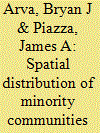| Srl | Item |
| 1 |
ID:
128156


|
|
|
|
|
| Publication |
2012.
|
| Summary/Abstract |
This paper presents a few stylized facts on the patterns of China's industrialization by computing a set of multi-dimensional measures on industrial concentration, regional specialization, and clustering based on census data at the firm level in 1995 and 2004. Our results show that China's rapid industrialization is characterized by the following patterns: industries have become more spatially concentrated; regions have become increasingly specialized; and firms have become more interconnected, both within industries and within regions. In addition, the number of firms is growing faster in clustered areas than non-clustered ones. Together these patterns suggest that China's industrialization process is largely cluster-based-a phenomenon in which a large number of highly interconnected firms are located within a well-defined geographic region.
|
|
|
|
|
|
|
|
|
|
|
|
|
|
|
|
| 2 |
ID:
143598


|
|
|
|
|
| Summary/Abstract |
Qualitative studies of terrorist movements frequently highlight the importance of diaspora communities as important factors in producing and sustaining terrorist activity in countries. The underlying theoretical argument is that bifurcation of tight-knit minority communities between countries nurtures separatist or irredentist sentiments among affected community members, thus prompting terrorist activity, while minority community members in other countries might mobilize financial and political resources to support terrorist activity among their compatriots. In this study, we empirically test whether transnational dispersion, versus domestic concentration, of minority communities in countries produces higher incidents of terrorism. Conducting a series of negative binomial estimations on a reshaped database of around 170 countries from 1981 to 2006, derived from the Minorities at Risk database and the Global Terrorism Database, we determine that both transnational dispersion of kin minority communities and domestic concentration of minorities within countries increase terrorism and that transnational dispersion is a particularly robust predictor of terrorist attacks.
|
|
|
|
|
|
|
|
|
|
|
|
|
|
|
|